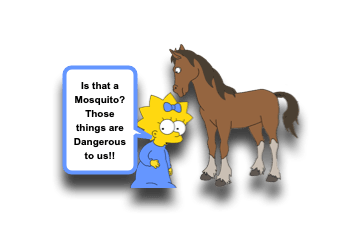Eastern Equine Encephalitis

We have previously discussed how saying “It’s JUST a virus,” is not comforting to families and may undermine your credibility. For one, this phrase minimizes the family’s concern… and secondly, viruses can be quite problematic (ex, Influenza, Varicella, HSV, Reye’s Syndrome, EBV). Recently, while we have been wrestling with increasing numbers of vaccine-preventable illnesses caused by viruses (say hello to Measles and Mumps again), there has been an increase in cases of another potentially deadly virus. Let’s remind ourselves of this devastating disease – Eastern Equine Encephalitis:
Eastern Equine Encephalitis: Basics
- Eastern Equine Encephalitis Virus is an alphavirus transmitted by mosquitoes. [Lindsey, 2018]
- Transmitted from infected birds via mosquitoes that are in freshwater or hardwood swamp environments.
- These mosquitoes can transmit the infection to horses, llamas, and humans (and other mammals).
- EEEV is not transmitted from humans to other humans or other species. [Lindsey, 2018]
- Humans do not develop high enough viremic levels to allow feeding mosquito to obtain the EEE virus.
- Humans are considered to be “dead-end-hosts.”
- EEEV cases occur sporadically, in small clusters, and also in larger outbreaks.
- EEEV cases are typically seen along the Atlantic and Gulf coasts of the US.
- States that account for the predominance of cases = North Carolina, New Hampshire, Massachusetts, Alabama, Louisiana, Georgia, and Florida. [Gaensbauer, 2014]
- Outbreaks known to occur in Massachusetts about every 10-20 years.
- Florida is an important source of transmission to other states. [Heberlein-Larson, 2019]
- Cases typically occur from June to October. [Lindsey, 2018]
- EEEV cases can affect any age, but the highest infection rates seen in: [Lindsey, 2018]
- Children <5 years of age
- Adults >70 years of age
Eastern Equine Encephalitis: The Illness
- Most infected humans have NO APPARENT illness. [Lindsey, 2018]
- Systemic symptoms include (similar to every other viral illness): [Lindsey, 2018]
- Acute Fever
- Chills
- Malaise and Myalgias and Arthralgias
- < 5% of infected patients develop meningitis / encephalitis. [Lindsey, 2018]
- EEEV can cause one of the most severe forms of encephalitis in North America.
- Fortunately, neuroinvasive disease is rare (average annual incidence = 0.04 cases per million children) [Gaensbauer, 2014]
- Neuroinvasive disease presents with: [Lindsey, 2018]
- Headache
- Altered Mental Status
- Seizures
- Coma may develop within 1 week on mosquito bite.
- MRI imaging of severely affected patients characteristically show early involvement of the basal ganglia and thalami, which distinguishes it from HSV encephalitis. [Deresiewicz, 1997]
- Neuroinvasive disease results in: [Lindsey, 2018; Deresiewicz, 1997]
- Lasting neurologic morbidity in 50% of cases
- Fatality in 30% case
Eastern Equine Encephalitis: Management
- There is no licensed vaccination available for humans (there is for horses). [Lindsey, 2018]
- There is no clear effective treatment, but it focuses on supportive management: [Lindsey, 2018]
- Anti-Seizure therapies
- Aggressive management of intracranial hypertension. [Wendell, 2013]
- High-dose steroid therapy has been used. [Wendell, 2013]
- IVIG has been used. [Wendell, 2013]
- Prevention is the best strategy! Reduce the risk of infection by:
- Avoid being bitten by the bugs!
- Avoid being outside between dusk and dawn.
- Wear long sleeves and pants (less than ideal when it’s summer).
- Use mosquito repellent with DEET, Permethrin, Picaridin or Oil of Lemon Eucalyptus.
- Don’t use DEET products for infants < 2 months of age.
- Avoid breeding more mosquitoes.
- Any little puddle that lasts for more than 4 days is a breeding ground for these critters.
- Remove standing water from around your home.
- Avoid being bitten by the bugs!
Moral of the Morsel
- Viruses are nothing to sneeze at! EEEV can cause coma in a very rapid period of time. Fortunately, this is rare.
- Prevention is the best strategy… as treatment is simply trying to prevent brain herniation! Get rid of standing water and avoid dusk!
References
Heberlein-Larson LA1,2, Tan Y3, Stark LM2, Cannons AC2, Shilts MH3, Unnasch TR1, Das SR3. Complex Epidemiological Dynamics of Eastern Equine Encephalitis Virus in Florida. Am J Trop Med Hyg. 2019 May;100(5):1266-1274. PMID: 30860014. [PubMed] [Read by QxMD]
Lindsey NP1, Staples JE1, Fischer M1. Eastern Equine Encephalitis Virus in the United States, 2003-2016. Am J Trop Med Hyg. 2018 May;98(5):1472-1477. PMID: 29557336. [PubMed] [Read by QxMD]
Berlin D1, Gilani AI2, Grewal AK1, Fowkes M2. Eastern equine encephalitis. Pract Neurol. 2017 Oct;17(5):387-391. PMID: 28754695. [PubMed] [Read by QxMD]
Mukerji SS1, Lam AD1, Wilson MR2. Eastern Equine Encephalitis Treated With Intravenous Immunoglobulins. Neurohospitalist. 2016 Jan;6(1):29-31. PMID: 26740855. [PubMed] [Read by QxMD]
Gaensbauer JT1, Lindsey NP2, Messacar K1, Staples JE2, Fischer M3. Neuroinvasive arboviral disease in the United States: 2003 to 2012. Pediatrics. 2014 Sep;134(3):e642-50. PMID: 25113294. [PubMed] [Read by QxMD]
Wendell LC1, Potter NS, Roth JL, Salloway SP, Thompson BB. Successful management of severe neuroinvasive eastern equine encephalitis. Neurocrit Care. 2013 Aug;19(1):111-5. PMID: 23733173. [PubMed] [Read by QxMD]
Armstrong PM1, Andreadis TG. Eastern equine encephalitis virus–old enemy, new threat. N Engl J Med. 2013 May 2;368(18):1670-3. PMID: 23635048. [PubMed] [Read by QxMD]
Silverman MA1, Misasi J, Smole S, Feldman HA, Cohen AB, Santagata S, McManus M, Ahmed AA. Eastern equine encephalitis in children, Massachusetts and New Hampshire,USA, 1970-2010. Emerg Infect Dis. 2013 Feb;19(2):194-201; quiz 352. PMID: 23343480. [PubMed] [Read by QxMD]
Deresiewicz RL1, Thaler SJ, Hsu L, Zamani AA. Clinical and neuroradiographic manifestations of eastern equine encephalitis. N Engl J Med. 1997 Jun 26;336(26):1867-74. PMID: 9197215. [PubMed] [Read by QxMD]

